The data-driven company understands how to leverage data in value-creating contexts. To reach the point where data becomes the foundation for innovation, you must establish the right processes, engage the right employees, and adopt a data-focused perspective on your business development.
Data and data science have been popular topics for many years. Articles such as “Data Scientist: The Sexiest job of the 21st Century”, have helped turn data experts into digital rock stars.
Reading through our writings, one can conclude that, for the most part, we sing the same song. Data is the company’s most important resource, and in the age of digitalization, most of us build our businesses precisely on data.
The data-driven company knows how to leverage this vast amount of data to its advantage. To reach a point where data can be effectively used, you must establish the right processes, engage the right employees or users, and adopt a data-focused perspective on your business development.
Why should you be “data-driven”?
Whether we talk about financial data, customer data, sales data, or product data, you probably already have one or more activities underway where data fuels the engine that drives your business forward.
At PicoPublish, product data is often the focal point of our work when implementing PIM solutions and building ecommerce platforms.
We often say, “your customer buys your product based on data”. When your customers shop online, their final purchase decision relies on the data you present about your products.
The customer’s interaction with your digital solutions therefore tells you a lot about their usage patterns and can be decisive for your decisions in developing new products and services.
No matter what type of data you work with, the idea of improving how you acquire, ensure the quality of, enrich, and interpret data is crucial for the products and services you offer to the market.
That’s why it’s also beneficial to take a more systematic approach when identifying opportunities to strengthen data work within your organization.
What does it mean to be data-driven? And how does it create value?
Based on the book “Data Driven” af Dhanurjay Patil og Hilary Mason ,we take a closer look at how companies can work purposefully towards becoming more data-driven in their decision-making processes.
This involves, among other things:
-
Recruiting/building the right skills
-
Establishing a range of processes around data collection, preparation, and utilization
-
Democratizing access to data
-
Continuously working to improve the company’s analytical capabilities
We contextualize the book’s insights for a Danish setting, drawing on our own work to comment on the points made in the book.
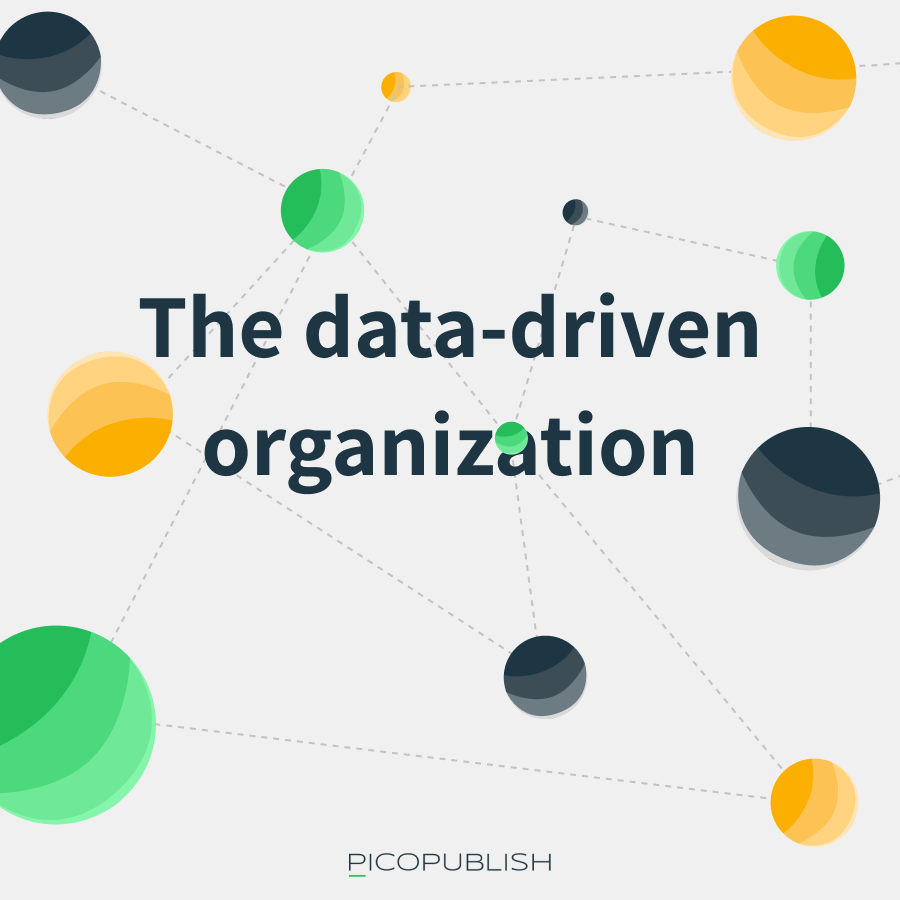
Den datadrevne organisation
We have previously discussed The Economist’s statement that data has overtaken oil as the world’s most valuable resource. This statement from The Economist dates back to 2017, and we must acknowledge that even in 2022, we remain deeply dependent on data.
Large tech giants like Google (Alphabet), Amazon, and Meta (Facebook) have experienced employee growth of between 20 and 30% since 2019 — translating to tens of thousands or even hundreds of thousands of new employees in a steadily rising trend.
This demonstrates that these data-driven giants are highly successful in leveraging their core business foundation — namely data — to develop and expand their businesses.
Want to talk data?
If you'd like to hear our take on how data can help your business execute, grow, and scale, we're ready for a no-obligation conversation.
Create a data-driven culture and leverage your data in value-creating contexts
One of the first points in Data Driven is that “lots of data” is not a goal in itself. A few years ago, the message was that every company should start collecting as much data as possible. This has proven to be both expensive and cumbersome—especially if you haven’t managed to transform your data into information, knowledge, or solutions that create value (i.e., innovation).
Instead, the goal should be to build a culture where “lots of data” can consistently be used in “many value-creating activities.”
Companies that uncritically choose to build large data warehouses or data lake setups rarely gain any advantages as long as they cannot convert their data into innovation.
Creativity as a key concept
For example, the data point “37 degrees Celsius” is not useful without context. If we’re talking about the “weather,” that data point means one thing. If it refers to the “temperature in your oven,” it means something completely different.
Building a data-driven culture primarily means becoming able to critically relate to the data we collect and how we handle this data.
Fundamental to the success of a data-driven company is the human creativity that transforms data from zeros and ones into connections, ideas, and opportunities. This creativity must be supported by both organizational factors (processes, culture) and technologies (systems, methods).
Before we can do data-driven business development, we need a basic understanding of what data is and what it takes for data to become a usable asset.
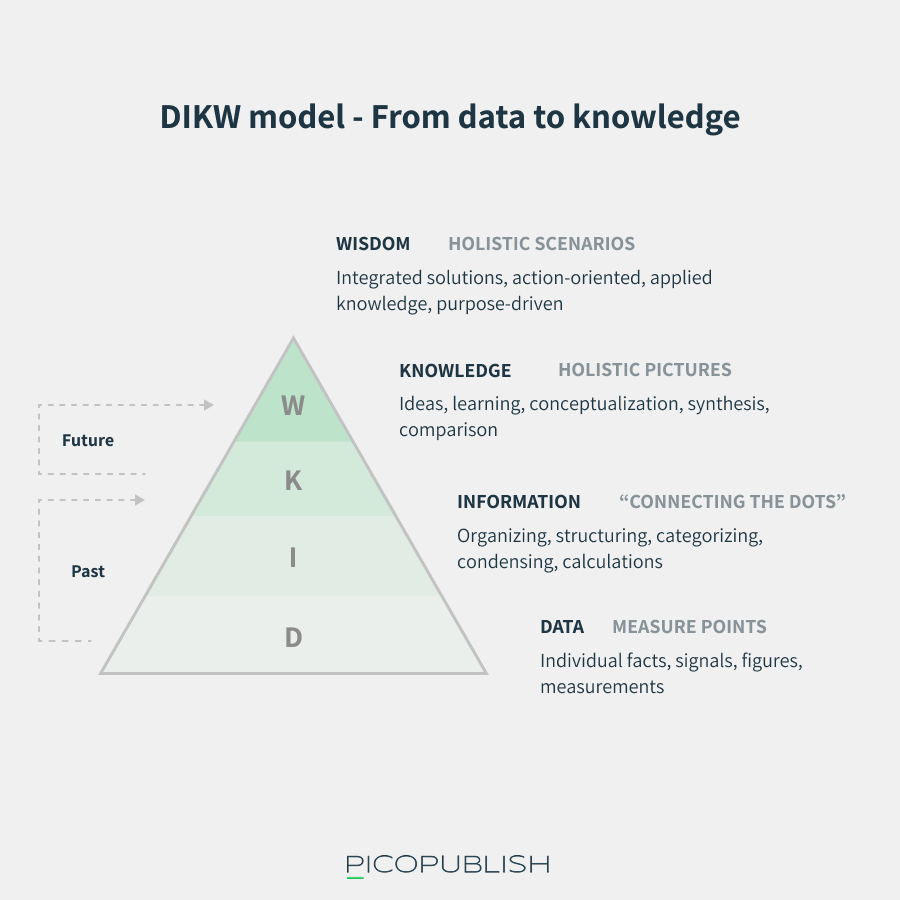
From data to knowledge – a brief presentation of the data journey
Data in itself has no value. It is only when data is used within a specific context that we can begin to transform data into information, information into knowledge, and knowledge into wisdom.
The so-called DIKW models are often used to describe the process data must go through before it becomes useful in a given context.
DIKW stands for:
-
Data
-
Information
-
Knowledge
-
Wisdom
The hierarchy in the model emphasizes the necessity of processing your data to gain insights that can be used to navigate in a commercial context (e.g., "Our machines overheat after two hours of production — we should give them a break or improve the cooling").
Explaining the DIKW model
Let’s look at the individual components of the model:
-
Data
Raw, unrefined signals
Example: "37" -
Information
Meaningful, enriched data
Example: "The temperature gauge on my oven reads 37" -
Knowledge
Contextualized information
Example: "I’m cooking a roast, and the oven’s temperature gauge reads 37" -
Wisdom
Applied knowledge
Example: "I’m preparing a pork roast that needs to be done in 2 hours. The oven reads 37 degrees, so I should wait to put the roast in until it reaches 200 degrees"
In working with data, the goal is to give raw signals a context. This context allows us to develop intuition about which questions our data can help answer.
Using the DIKW model, you can quickly identify what level your data has reached and work purposefully toward maturing your data—either by using tools (technologies that visualize, compare, or calculate data) or through analysis.
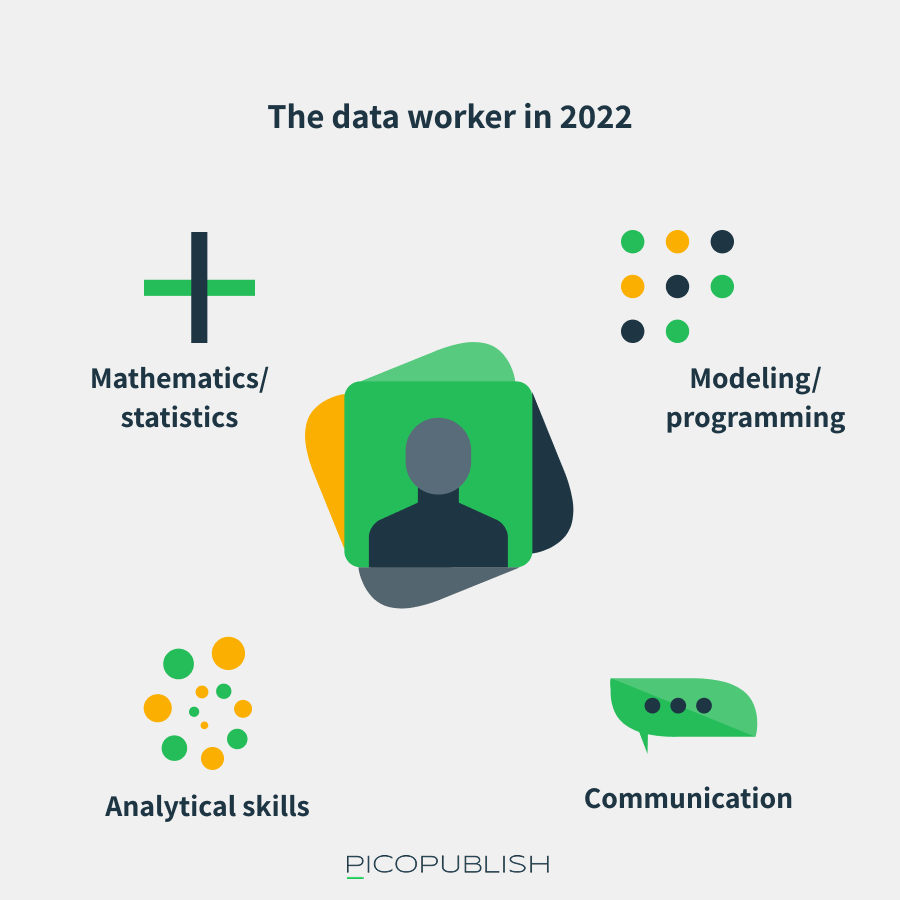
Theme #1 – The Necessary Competencies
The authors of Data Driven start with the employee perspective: “Culture starts with people in your organization, and their roles and responsibilities.”
A particularly important role in building a data-driven organization is that of the data scientist. This job title has been called the “sexiest job of the 21st century” by publications like Harvard Business Review.
However, data scientists don’t necessarily perform fundamentally new or different tasks. Roles involving statistics, data analysis, and programming have always existed in companies. What’s new is that these skills are now often combined in a single person.
Lesson 1: Successful data-driven companies understand the importance of data expertise.
When large organizations like Walmart and the US Department of Commerce have succeeded with their data initiatives, it’s largely because they embraced this kind of role.
Whether it’s a Chief Data Officer (CDO), data scientist, or another title, what matters is that the company strategically commits to basing decisions on data.
Key capabilities for this type of employee include:
-
Working with math and numbers at a high level
(Large data sets typically require quantitative analysis) -
Modeling data (programming and infrastructure design)
-
Preparing data for analysis (database modeling, etc.) to generate new insights
-
Analytical thinking
(Asking the right questions at the right time is critical for useful analyses) -
Communicating their work
(Without effective communication, insights won’t create value)
The data employee’s core purpose is to provide solid analyses and insights to company leadership.
What can we take from this?
We don’t necessarily believe companies must interpret the “data scientist” role literally. Even though Danish universities are now offering degrees called “Data Science,” it’s unrealistic to expect a single employee to carry full responsibility alone.
This reflects the natural increase in data volume and complexity, which demands data-driven teams to manage growing challenges.
However, applying the skills above in everyday work is productive. In our experience with PIM (Product Information Management), these competencies frequently come into play.
Locally, we often see teams rather than lone specialists. Roles such as Business Intelligence consultants, traditional developers, and data analysts are common among our clients and colleagues.
Any transformation process — including PIM implementations — fundamentally depends on leadership support. Therefore, making “the data-driven employee” a strategic priority is valuable, whether by hiring the right talent or training existing staff.
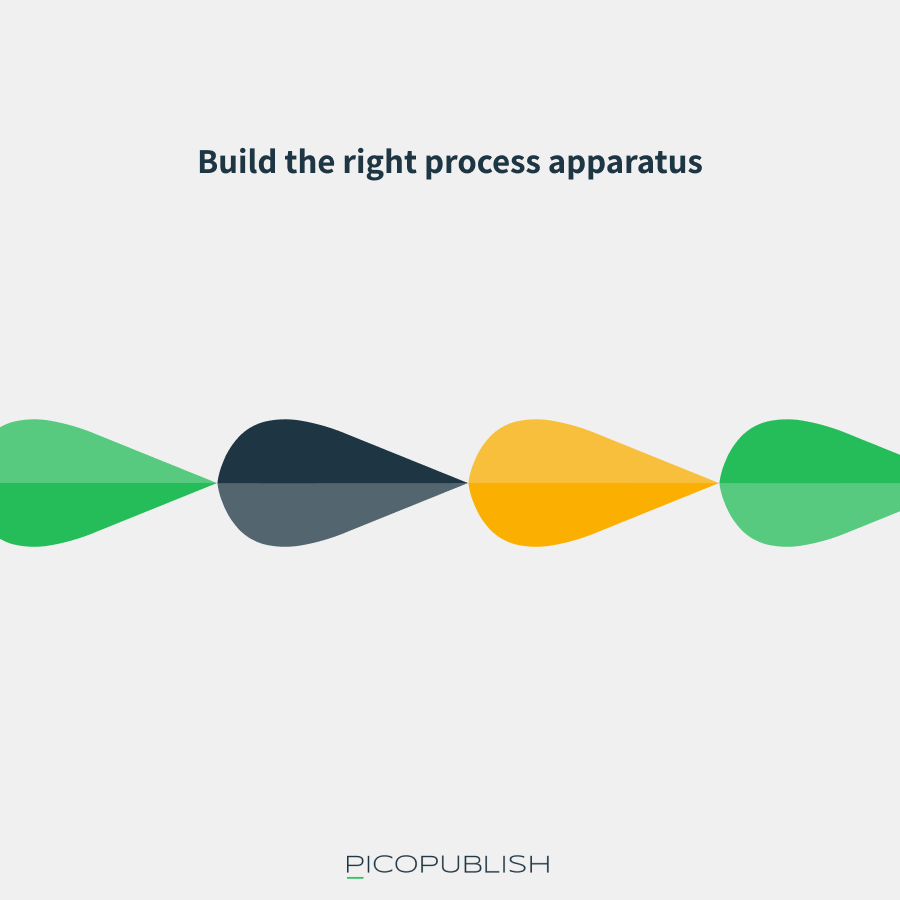
Theme #2 – Build a strong process framework
With a handle on the data employee, the authors now turn their attention to the organizations themselves — the data-driven companies that form the core focus of the book.
They first highlight some of the major corporations that have succeeded in their digital transformations:
-
Walmart, which since the 1970s has digitized its physical stores (e.g., with barcode scanners) to strengthen its data foundation
-
FedEx, which has used GPS data to reduce driven kilometers by 100 million
-
General Electric, which has used data about its jet engines to optimize communication both to pilots and to the engineers who build the engines
A footnote regarding General Electric is that a 1% optimization in the operation of their jet engines can result in annual savings exceeding 100 billion Danish kroner.
So, what enables these companies to work with data and gain business advantages?
Lesson 2: The data-driven company works in a structured way with data
In Data Driven, the successes of the aforementioned companies are highlighted as the result of a finely tuned process apparatus.
Companies that succeed with their data initiatives are able to work systematically with their data collection and processing:
“[the data-driven organization]... acquires, processes, and leverages data in a timely fashion to create efficiencies, iterate on and develop new products, and navigate the competitive landscape...”
The first step is thus data acquisition and processing, which according to the authors can account for up to 80% of the work involved with data.
Data acquisition is typically the result of a design choice; using one or more technologies, data is collected about:
-
user actions
-
system states
-
transactions
-
products
-
and much, much more.
Data processing includes all activities related to cleaning, sorting, troubleshooting, and categorizing data, making subsequent analysis possible. For companies with large volumes of data, developing a standardized process specifically for this part of the work is significantly more challenging than many assume.
If one succeeds in creating a healthy culture around this work with data, data quality will also be very high. This provides the foundation for better analyses and fewer errors in the conclusions drawn based on data.
What can we use this knowledge for?
Perhaps the most surprising statement (to some) is that a full 80% of the work with data takes place in acquisition and refinement of data.
From a product data perspective, this is not far from reality, where establishing the correct data foundation is by far the largest task. Once data is properly acquired and enriched, distribution through various channels is usually not what topples the house of cards.
If data acquisition also involves motivating and activating suppliers who need to mature to deliver data digitally directly into PIM, the resource demand on this task is also considerable. But it is also in these processes that the great potential for efficiency gains and optimization lies hidden.
Typically, automation of previously manual processes and workflows is a key focus here. The benefit of achieving greater automation is often that you get better and more precise data (e.g., error and downtime logs) and free up valuable time for other activities.
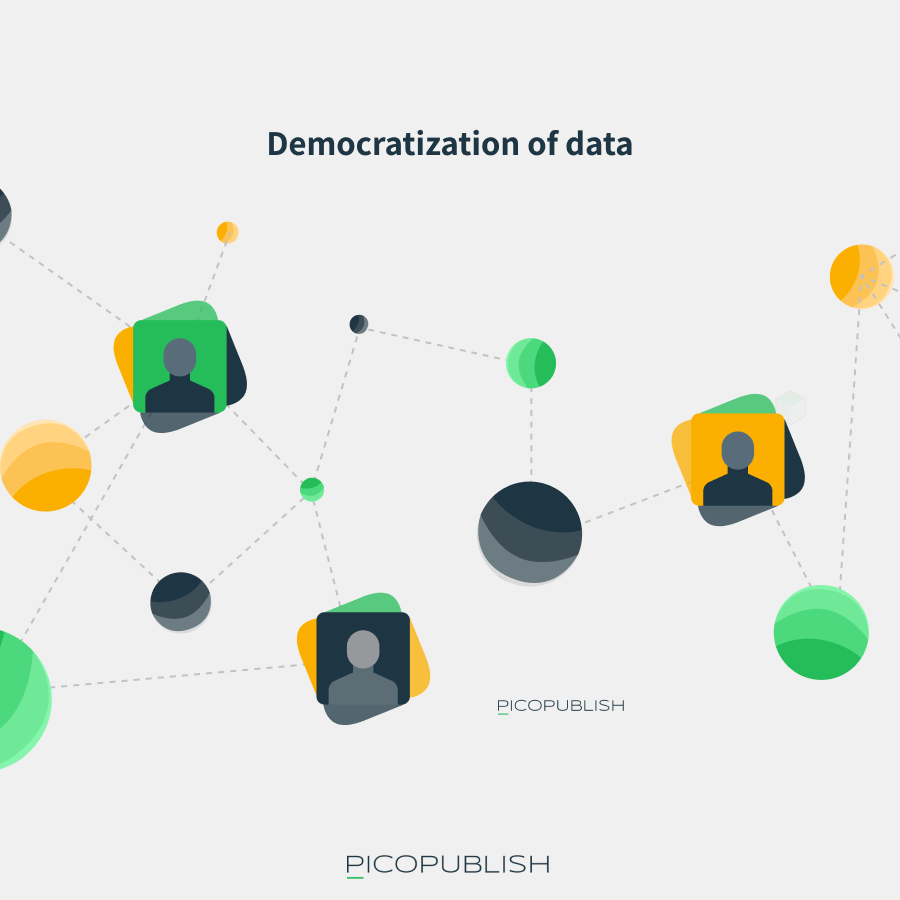
Theme #3 – Democratization of data is crucial
Structure and processes alone are not enough. According to the authors of Data Driven, many fall prey to a “build it, and they will come!” mentality, mistakenly expecting that data collection and preparation alone are sufficient to create a data-driven company.
Just as oil isn’t worth much without combustion technology, data is also of little value without someone or something to interpret it.
The book emphasizes the importance of data sharing internally within the company through yet another example. At Google and LinkedIn, basic SQL skills became a requirement in their recruitment processes. This was intended to ensure that all employees could access data and make informed decisions in their projects.
NGOs and other interest organizations have also recognized the value of exposing data (so-called “open data”), allowing users and interested parties to engage with the NGO’s work.
Another example is found in Chicago, where a frustrated citizen developed a tool to track the number of potholes. The service helped the local government respond more effectively to dangerous potholes.
Learning 3: The data-driven company democratizes as much data as possible (within legal limits)
Companies that succeed with their data initiatives are those that manage to democratize data access, so it doesn’t just gather dust in one or more closed databases.
So-called “open datasets” are one way to democratize access to data. At Statistics Denmark (dst.dk), data has been openly available for many years, and they have even built a visualization and analysis engine that most people can use without special training. This allows virtually anyone to access data in a way that enables the generation of new knowledge.
In Data Driven, the authors introduce a new role — the “Data Steward.” This is a kind of digital data custodian whose primary task is to ensure a strong foundation in the organization’s technological and methodological support of data work.
What can we use this knowledge for?
When ecommerce is the focus, it is natural to view the PIM system as a stand-in for the aforementioned “Data Steward.” One purpose of a PIM system is to serve as a Single Source of Truth for product data, which improves the quality of that data.
Additionally, the PIM system allows virtually everyone to interact with data, create new connections, new processes (e.g., alerts, notifications, etc.), and new channels. It is itself a technological support for data work.
Democratizing data and knowledge is not a groundbreaking idea in itself. Nonetheless, it is important to keep it in mind. For many reasons, the PIM system is one of several technologies that can help facilitate this democratization.
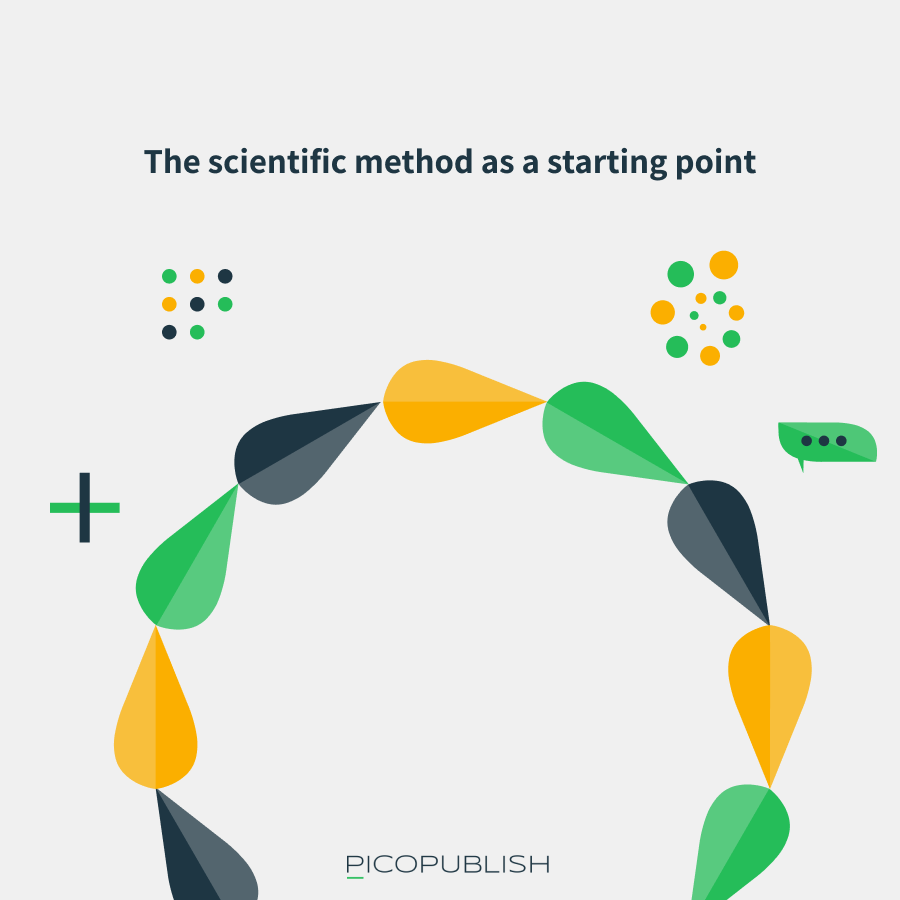
Theme #4 – Start from the Scientific Method
The three previous themes address the steps leading up to the analysis.
The analysis itself is the core of perhaps the most critical part of value-creating work with data.
As mentioned earlier—if you fail to ask the right questions, the answers your data provides are worthless.
In Data Driven, the authors suggest starting with a simple, scientifically inspired methodological foundation for your analysis:
-
Start with data—always!
-
Build an intuition about the data and the questions it can answer (for example, a simple chart showing some major fluctuations in the data)
-
Formulate one or more concrete questions
-
Use data to verify if the question is valid
-
Build a framework that allows you to test and experiment with data
-
Analyze your results and find insights related to your questions
Based on this process, the company must now refine its approach to analysis work.
Learning 4: The data-driven company invests in analytical skills
When building a data-driven organization, it is too risky to let all knowledge reside in a single employee (e.g., a “data scientist”). Just as democratizing data makes data a tool for more people in the company, the company’s methods and analytical skills should also be democratized.
The claim in Data Driven is that most data analyses resemble scientific work, which also means that there is very likely a generic analysis process that can be applied and adjusted again and again.
What can we use this knowledge for?
“Culture eats strategy for breakfast.” That’s what Peter Drucker said.
The best intentions often become victims of a company culture that does not readily absorb new ideas, processes, and technologies.
Although the scientifically based analytical method has its merits, we rarely see companies take such an academic approach in their work with product data.
In ecommerce, there is typically a greater focus on expanding architecture with value-creating integrations—e.g., to suppliers, so they can deliver data directly into the PIM system—than on methods, which can often feel like constraints on employees’ freedom to act.
That’s not to say scientific analysis should be totally ignored.
One example of a concrete tool that can help with point 2 above would be a dashboard.
A good dashboard will typically reveal immediate insights in a dataset (largest outcomes, volumes, dependencies, and other facets of the data).
The loose ends
"Data driven" addresses in its many workings some themes worth briefly mentioning as a conclusion.
Processes and methods over tools
A bit like the manifesto for agile software development, which reads "individuals and interactions over processes and tools," the authors advocate that interactions and processes should trump a focus on tools:
"The secret of great data science is that the tools are almost irrelevant. An expert practitioner can do better work in the bash shell environment than a nonexpert can do in r."
When choosing which tools to work with, usability is typically an important parameter, especially if non-technical colleagues need to find their way around the tool’s interface.
A good tool also supports teamwork and communication—again to avoid data silos that only benefit a few.
In our view, a good path to a better it system landscape is standardization. By standardization, we mean using systems for what they are designed to do. This avoids, for example, unnecessary downtime and poor performance. It also typically makes systems easier to work in, as you don’t have “one gadget” that has to do everything at once.
Look at your data often
In "data driven," the authors are both for and against dashboards. On one hand, dashboards should not be seen as the end product, as a dashboard is not high enough in the dikw model for data to be considered fully processed.
On the other hand, dashboards are useful early in the analysis process, where frequent exposure to data increases the reader’s intuition when working with data.
Furthermore, dashboards highlight issues like data quality and recent changes, which can help create a culture around data work that is more transparent than otherwise.

